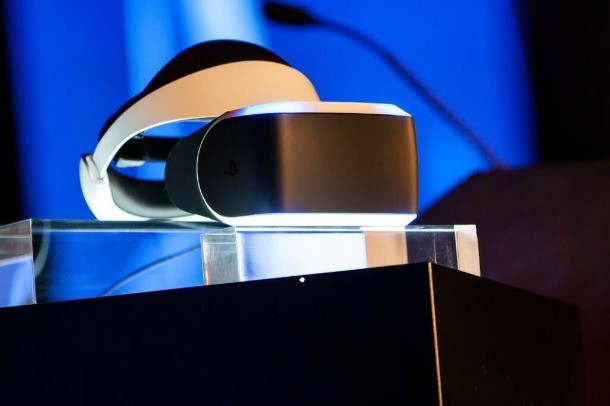Please support Game Informer. Print magazine subscriptions are less than $2 per issue
'Virtual Reality Is The Next Innovation From PlayStation,' Says Shuhei Yoshida

After much speculation, Sony has confirmed its own virtual reality project. Sony's entry into the market is currently being announced at a GDC panel in San Francisco.
Shuhei Yoshida announced the initiative, proclaiming that Sony will "push the boundaries of play." The device is called "Project Morpheus," a head-mounted display.
Morpheus will be available at the Sony booth at GDC for demos starting Wednesday. It is designed for the PlayStation 4, and will work in conjunction with the PlayStation camera and Move. The unit on stage is not final, but it is the first software developer kit.
Yoshida says that Sony was inspired by Oculus VR and Valve, along with those in the community who are enthusiastic about virtual reality. Sony's Richard Marks, who took the stage to explain more about the project, including its application in science.
Working with NASA, Sony has created a demo that takes place on Mars with data captured from the Curiosity rover. In order to accomplish the goal of "presence" in virtual reality, Sony is focusing on six areas.
The first is "sight," and Sony is working on high resolution, low persistence optics. The PlayStation 4 will be instrumental in rendering the video.
Marks says that sound is important in games, but even more so in VR. "Having spacialized sound is really important," he says. "If you didn't have that, it would be a cluttered mess inside your brain."
Next up is tracking, which sets VR apart from a simple cinematic display on your head with a wide field of view. The Morpheus will use the same kind of technology as PlayStation Move.
The Move also plays a major role in control. Marks says his area of expertise is game control, but that there are a lot of problems implementing it in VR. The lightbar on the Dual Shock 4 will be important, as will the Move, which Marks says was "ahead of its time."
Sony is focusing on ease of use, and making sure that the Morpheus is plug-and-play. It needs to be easy to adjust (or automatically adjust, Marks suggests). "We'll get that one nailed," Marks says.
The last item is arguably the most important: content. "We're going to need the whole development community if we want to succeed at VR," Marks says."We want to make PlayStation the best place for VR, not just for people who play games, but for developers."
Currently, Sony is working with Unity, Havok, Wwise, Criware, Crytek, Epic, Autodesk and more.
According to Anton Mikhailov, in research and development at Sony, virtual reality is a medium and not a peripheral. One of the keys is understanding that freedom of head movement is crucial, meaning that cutscenes and locked cameras don't work well. Arm positioning in VR is another challenge, because the virtual world might have barriers that the real world doesn't.
Software must be low latency with high framerate. The images must be rendered cleanly, with 3D audio helping with immersion.
Mikailov suggests that contact points, like a steering wheel and pedals and your back against a chair for a driving game. The closer the match, the better the feeling of presence.
Despite the PlayStation connection, Mikhailov suggests that non-gaming software has a place in the medium. Virtual tourism and interactive media might, such as a virtual cinema are examples.
The Morpheus will be a social experience despite the isolation provided by the headset, with both online and local options. The unit will include a mechanism to project the user's view on the screen.
The devkit is 1080p with a 90+ degree field of view and accommodates those that wear glasses. This is not final, but Mikhailov calls it a "good sweet spot for developers." The position and rotation is 1000 Hz with full 360 degree support. There's also prediction to help alleviate render latency. The tracking is handled by the PlayStation camera, which means you won't need to buy something new.
The headset includes sound rendering that mirrors the way our ears hear for an immersive experience that mirrors 60 virtual speakers around the user. It's not the same as virtual surround sound processing, and the unit features a port for plugging in a headset. Wireless headphones can be used, also.
Demos available at GDC include The Deep from Sony's London Studio that puts users in a shark cage. The Castle, made by United States R&D, which uses the Move. EVE Valkyrie is available for Project Morpheus, and Eidos Montreal has designed a special build of Thief that includes segments of the game.
During the Q&A segment, Sony confirmed that Project Morpheus currently has a five meter cable, though that may change. No specific frame rate and latency have been set as targets beyond "the highest frame rate and lowest latency we can get," Mikhailov says.
There's no time frame yet for release, but Mikhailov suggests that Sony would like to get it out into the public as soon as possible. The first party studios are currently experimenting. "I'm expecting more studios to work on something soon," Yoshida says.
As for age range, Sony hasn't yet determined if it will make recommendations for young users. "We've had young people try it, and they've been very excited by it," Mikhailov says.
Finally, if you're wondering about the name, "Project Morpheus," Sony says that it was a decision made last week. Is it a Matrix reference? "Sure," Marks jokes.










